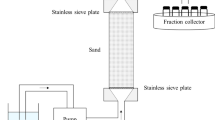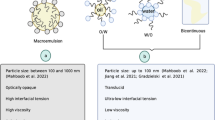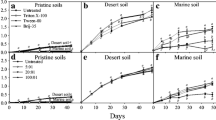Abstract
The objective of this work was to apply a microemulsion-based formulation for the removal of motor oil in laundry detergency at low salinity. To produce the desired phase behavior, three surfactants were used: alkyl diphenyl oxide disulfonate (ADPODS), sodium dioctyl sulfosuccinate (AOT) and sorbitan monooleate (Span 80). The mixed surfactant system of 1.5% ADPODS, 5% AOT and 5% Span 80 (13 parts ADPODS, 43.5 parts AOT, and 43.5 parts Span 80 of the total actives) was found to form a middle phase microemulsion (Type III) at a relatively low salinity of 2.83% NaCl. When this formulation was diluted, detergency performance increased with increasing total surfactant concentration and leveled off above about 0.1% total actives on the three types of fabrics studied (pure cotton, 65/35 polyester/cotton blend, and pure polyester). Detergency was found to improve with increasing hydrophilicity of the fabric with cotton being cleanest after washing and polyester the most difficult to clean. To achieve a specified oil removal, less rinse water can be used if a higher number of lower-volume rinses are employed. An interesting characteristic of microemulsion-based formulations is that a substantial fraction of oil removal occurs during the rinse cycle. In this work, this removal is shown to be due to the low oil/water interfacial tension during initial rinsing and is therefore strongly correlated to residual surfactant concentration in the rinse steps. As a result, the number of rinses and the volume of water per rinse can profoundly affect detergency in these systems.














Similar content being viewed by others
References
Azemar N (1996) The role of microemulsions in detergency process. In: Solans C, Kunieda H (eds) Industrial applications of microemulsions. Marcel Dekker, New York, pp 375–387
Verma S, Kumar VV (1998) Relationship between oil–water interfacial tension and oily soil removal in mixed surfactant systems. J Colloid Interface Sci 207:1–10
Whang HS, Kim YJ, Ko SW (2001) Effect of hydrophile-lipophile balance values of surfactant mixtures on the detergency of oily-soiled single fiber. Text Res J 71:650–654
Carroll B (1996) The direct study of oily soil removal from solid substrates in detergency. J Colloid Interface Sci 114:161–164
Rosen MJ (2004) Surfactants and interfacial phenomena, 3rd edn. Wiley, New York, pp 141–142
Kissa E (1987) Evaluation of detergency. In: Culter WG, Kissa E (eds) Detergency theory and technology. Marcel Dekker, New York, pp 1–89
Raney KH, Benton WJ, Miller CA (1987) Optimum detergency conditions with nonionic surfactants: I ternary water surfactant-hydrocarbon systems. J Colloid Interface Sci 117:282–290
Bidyut KP, Satya PM (2001) Uses and applications of microemulsions. Curr Sci 80:990–1001
Thompson L (1994) The role of oil detachment mechanism in determining optimum detergency conditions. J Colloid Interface Sci 163:61–73
Dillan KW, Goddard ED, McKenzie DA (1980) Examination of the parameters governing oily soil removal from synthetic substrate. J Am Oil Chem Soc 57:230–237
Solans C, Dominguez JG, Friberg SE (1985) Evaluation of textile detergency of microemulsions in systems of water nonionic surfactant and hydrocarbon at low temperature. J Disp Sci Technol 6:523–537
Rybinski WV (2002) Surface chemistry in detergency. In: Holmberg K, Shah DO, Schwuger MJ (eds) Handbook of applied surface and colloid chemistry, Wiley, West Sussex, pp 53–72
Tongcumpou C, Acosta EJ, Quencer LB, Joseph AF, Scamehorn JF, Sabatini DA, Chavadej S, Yanumet N (2003) Microemulsion formation and detergency of oily soils: I phase behavior and interfacial tension. J Surfact Deterg 6:191–203
Tongcumpou C, Acosta EJ, Quencer LB, Joseph AF, Scamehorn JF, Sabatini DA, Chavadej S, Yanumet N (2003) Microemulsion formation and detergency of oily soils: II detergency formation and performance. J Surfact Deterg 6:205–213
Tongcumpou C, Acosta EJ, Quencer LB, Joseph AF, Scamehorn JF, Sabatini DA, Chavadej S, Yanumet N (2005) Microemulsion formation and detergency of oily soils: III performance and mechanisms. J Surfact Deterg 8:147–156
Dörfler HD, Grosse A, Krüssmann H (1996) The use of microemulsions as cleaning media. Tenside Surfact Deterg 33:432–440
Robbins ML (1977) Winsor type microemulsions. In: Mittal KL (ed) Micellization, solubilization and microemulsions. Plenum, New York, pp 713–754
Broze G (1994) Mechanisms of soil removal. In: Lange KR (ed) Detergents and cleaners: a handbook for formulators. Hanser, Munich, pp 29–41
Acosta E, Uchiyama H, Sabatini DA, Harwell JH (2002) The role of hydrophilic linkers. J Surfact Deterg 5:151–157
Acosta E, Uchiyama H, Tran S, Sabatini DA, Harwell JH (2002) Formulating chlorinated hydrocarbon microemulsions using linker molecules. Environ Sci Technol 36:4618–4624
Acosta EJ, Mellisa LA, Harwell JH, Sabatini DA (2003) Coalescence and solubilization kinetics in linker-modified microemulsions and related system. Langmuir 19:566–574
Graciaa A, Lachaise J, Cucuphat C, Bourrel M, Salager JL (1993) Improving solubilization in microemulsions with additives 1. The lipophilic linker role. Langmuir 9:669–672
Graciaa A, Lachaise J, Cucuphat C, Bourrel M, Salager JL (1993) Improving solubilization in microemulsions with additives 2. Long-chain alcohol as lipophilic linkers. Langmuir 9:3371–3374
Salager JL, Miñana-Perez M, Pérez-Sénchez M, Ramirez-Gouveia M, Rojas CI (1983) Surfactant-oil-water systems near the affinity inversion Part III: the two kinds of emulsion inversion. J Disp Sci Technol 4:313–329
Miñana-Perez M, Jarry P, Pérez-Sénchez M, Ramirez-Gouveia M, Salager JL (1986) Surfactant-oil-water systems near the affinity inversion Part V: properties of emulsions. J Disp Sci Technol 7:331–343
Salager JL (2000) Emulsion properties and related know-how to attain them. In: Nielloud F, Marti-Mestres G (eds) Pharmaceutical emulsions and suspensions. Marcel Dekker, New York, pp 73–125
Standard Guide for Evaluating Stain Removal Performance in Home Laundering (2000) Annual book of ASTM standards, vol 15.04. American Society for Test and Materials ASTM D 4265-98, West Conshohocken
Goel SK (1998) Measuring detergency of oily soil in the vicinity of phase inversion temperatures of commercial nonionic surfactants using an oily-soluble dye. J Surfact Deterg 1:221–226
Ghosh O, Miller CA (1987) Liquid-crystalline and microemulsion phase behavior in alcohol-free aerosol-OT/oil/brine system. J Phys Chem 91:4528–4535
Quencer L, Loughney TJ (2001) Detergency properties of alkyl diphenyl oxide disulfonate. In: Friedli FE (ed) Detergency of specialty surfactants, Marcel Dekker, New York, pp 145–165
Jakobi G, Löhr A (1987) Detergents and textile washing. Henkel, Germany
Chi YS, Obendorf SK (1999) Detergency of used motor oil from cotton and polyester fabrics. J Surfact Deterg 2:1–11
Obendorf SK, Klemash NA (1982) Electron microscopical analysis of oily soil penetration into cotton and polyester/cotton fabrics. Text Res J 40:434–442
Salager JL (2000) Formulation concepts for the emulsion maker. In: Nielloud F, Marti-Mestres G (eds) Pharmaceutical emulsions and suspensions. Marcel Dekker, New York, pp 19–72
Kegel WK, Lekkerkerker HNW (1993) Competition between a lamellar and a microemulsion phase in an ionic surfactant system. J Phys Chem 97:11124–11133
Bastogne S, David C (1998) Quaternary N-alkylaldonamide-brine-decane-alcohol system Part I: phase behavior and microemulsions. Colloids Surf A 139:311–320
Lee JM, Lim KH (2004) Changes in morphology of three-phase emulsions with temperature in ternary amphiphile/oil/water systems. Colloids Surf A Physicochem Eng Asp 248:57–65
Lee JM, Lim KH (2005) Changes in two-phase emulsion morphology in temperature-amphiphile concentration or fish diagram for ternary amphiphile/oil/water systems. Colloids Surf A 290:241–249
Queste S, Salager JL, Strey R, Aubry JM (2007) The EACN scale for oil classification revisited thanks to fish diagrams. J Colloid Interface Sci 312:98–107
Acosta EJ, Harwell JH, Sabatini DA (2004) Self-assembly in linker modified microemulsions. J Colloid Interface Sci 274:652–664
Scamehorn JF, Sabatini DA, Harwell JH (2004) Surfactants, Part I: fundamentals. In: Atwood J, Stead J (eds) Encyclopedia of supramolecular chemistry. Marcel Dekker, New York, pp 1458–1469
Acknowledgments
Research facilities and financial support for this work was provided by the Petroleum and Petrochemical Consortium, Ministry of Education, and the Research Unit of Applied Surfactants for Separation and Pollution Control, Rachadapisek Somphoch Fund, Chulalongkorn University, respectively. In addition, the industrial sponsors for the Institute of Applied Surfactant Research, University of Oklahoma are acknowledged. They are Akzo Nobel, Clorox, Conoco/Phillips, Church and Dwight, Dow, Ecolab, Halliburton, Huntsman, Oxiteno, Procter & Gamble, Sasol North America, Shell Chemical, and Unilever.
Author information
Authors and Affiliations
Corresponding author
About this article
Cite this article
Tanthakit, P., Chavadej, S., Scamehorn, J.F. et al. Microemulsion Formation and Detergency with Oily Soil: IV. Effect of Rinse Cycle Design. J Surfact Deterg 11, 117–128 (2008). https://doi.org/10.1007/s11743-008-1062-x
Received:
Accepted:
Published:
Issue Date:
DOI: https://doi.org/10.1007/s11743-008-1062-x




